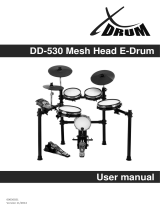FGDP-30 User Guide 13
CAUTION
• Before connecting an external audio device, turn off the power of both this product and
the external audio device. Also, before turning the power on or off, make sure to set all
volume levels to minimum (0). Otherwise, damage to the devices, electrical shock, or
even permanent hearing loss could occur.
NOTICE
• To avoid possible damage to the external device, first turn on the power to this product,
then to the external device. When turning off the power, do so in reverse order: first turn
off the power to the external device, then to this product.
@
[USB TO HOST] terminal
This product is equipped with a [USB TO HOST] terminal.
Notice when using the [USB TO HOST] terminal
When connecting a USB cable to this terminal, make sure to hold the connector (plug) and
insert it all the way in the correct vertical and horizontal direction (without tilting it) to
prevent poor contact. After connecting the USB cable, ensure that excessive force is not
applied to the connector (plug). In addition, check the notes regarding USB connections in
the “Precautions” section of the Startup Guide included in the product package.
• See this page for details about connecting a charging device.
• Depending on the model of the computer/smart device and the OS, a USB connection




















